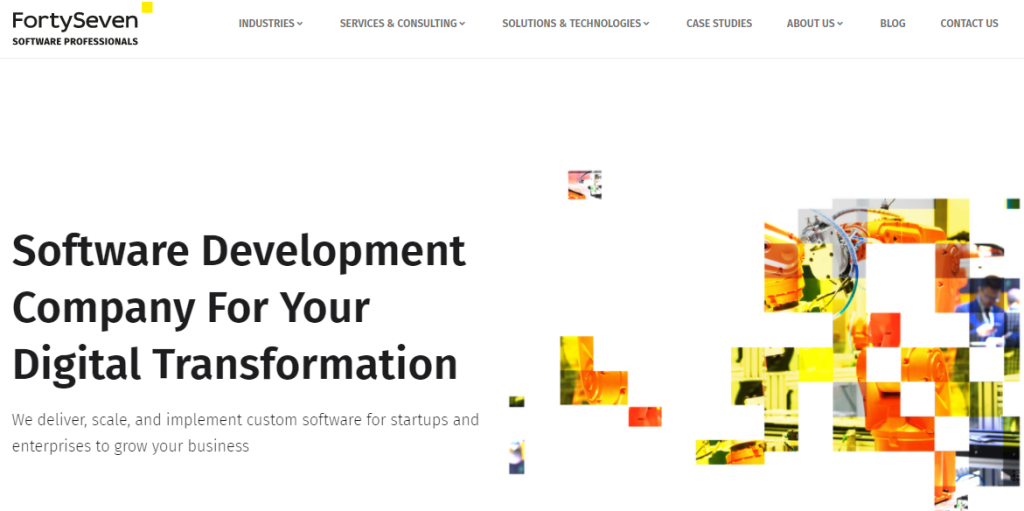Knowing how to interpret data is a great challenge for companies like mobile app development companies, custom software development companies, and businesses.
The competitive environment of recent years has been characterized by strategies to enter the wave of digital transformation. This has made companies take steps not to reduce themselves to very small market niches or even face the disappearance of their organization.

1. Descriptive Analytics
Out of the four types of data analytics used to improve decision-making and used by most development companies, descriptive is the simplest and the most straightforward to understand. It answers the question, “what happened.” It answers questions using techniques like summary statistics, data aggregation, data mining, clustering, and reports.
People mainly use this type of data analytics in different business areas, especially in sales, marketing, custom software development companies, and finance departments.
For example, if you want to buy a product, but you want the latest version of the product but don’t know how to go about it. It’s simple, by applying descriptive analysis to the historical data, you can get information on what items people were least willing to buy in that period. This analysis can also provide the overall sales picture, showing how the store was performing in general.
The descriptive analysis combines raw data from various sources to provide valuable insight into the past. However, these findings show something wrong or right, and they don’t explain why.
For this reason, highly data-driven, custom software development firms and decision-making companies are not satisfied with descriptive analytics alone.
They prefer to combine it with other types of data analytics. You can’t survive without using it, but it can’t be the only type to use. It will only tell why someone has stopped doing something but won’t suggest why it stopped working.
2. Diagnostic Analytics

Diagnostic analytics is different from Descriptive analytics by the question it answers. It answers the question “why it happened” by asking for the cause of a situation in a company or business. It provides a broader perspective and insights received after the descriptive analysis.
Diagnostic analytics allows you to identify problems and explain why they happened. This type of analytics includes likelihood, probability, or a distributed outcome. It implies such techniques as regression analysis, principal component analysis, and sensitivity analysis.
This type of analysis helps businesses and development companies find interconnection between data, which can be used in many cases. Companies place their bets on diagnostic analysis because it provides detailed information on a specific problem.
In addition, the company must have detailed information at its disposal. Otherwise, data collection can be time-consuming and individual for each problem.
3. Predictive Analytics
Predictive analytics tells what is likely to happen. It uses descriptive and diagnostic analysis findings to spot trends, groupings, and exceptions, and to predict future trends, making it a valuable forecasting tool.
Predictive analysis is more complex than descriptive and diagnostic analytics, and it requires scientific expertise. It may include the following:
Predictive Modeling
It is all about using quantitative or qualitative data analysis to find patterns and solve problems. By using predictive modeling, you get to make a specific decision, for example, changing some elements in a business process.
Time Series Data Mining

This is why it is said that it requires scientific expertise because it collects data of some things like weather, discovers patterns, and makes a forecast based on the data collected.
Despite the many advantages that predictive analytics brings, it is essential to understand that forecasting is only an estimate, the accuracy of which is highly dependent on the quality of the data and the stability of the situation, thus requiring careful treatment and continuous optimization.
Predictive analytics also enables a telecommunications company to identify the most likely subscribers to reduce their spending and unleash targeted marketing activities to remedy it. It also helps custom software developers on why something happened when they are working on mobile app development or software development.
4. Prescriptive Analytics
This type of analytics answers the question “How to make something happen?” providing decision-makers with the optimal action plan. Prescriptive analytics can be helpful when making data-driven decisions in custom software development companies and businesses.
The purpose of prescriptive analytics is to prescribe what action to take to eliminate a future problem or take full advantage of a trend.
Prescriptive analytics uses tools and technologies like machine learning, mobile app development, artificial intelligence, and business rules, making it easy to implement and manage.
What Types of Data Analytics Does Your Business Need?

To define the right combination of data analysis to use for your software company or business, you need to know the answer to the following questions:
- What’s the current state of data analytics in my company?
- How deep do I need to use data analysis for decision-making in my company?
- Are my answers to the above questions obvious?
If you can answer the following questions well, this will determine the kind of data analytics strategy and types you will use. It is advised to always use data analytics from the simplest to the most advanced – from descriptive analytics to prescriptive analytics.
Benefits of Data Analytics for Your Business

Personalize the Customer Experience
Software development companies and businesses collect customer data from many channels like e-commerce and social media. Data analytics helps create a customer profile, and it enables businesses to gain insights into customer behavior to know what to take to provide more customer experience.
For example, a business could run a predictive analytic on e-commerce transaction data to determine products to recommend at checkout to increase sales.
Inform Business Decision-Making
Entrepreneurs can use data analytics to improve their business decision-making and also help to minimize financial losses. Predictive analytics can suggest what will happen if anything changes your company or business, and prescriptive analytics will indicate how to handle the situation.
Mitigate Risk and Handle Setbacks

Risks are everywhere, especially in organizations, businesses, or development companies. Some risks include customer theft, employee safety, and legal liability. Data analytics helps to mitigate risk, handle setbacks and even prevent them.
For example, you can use data analytics to determine which stores are at the highest risk for theft. This data can then be used to determine the security measures to take.
Conclusion
The four types of data analytics are great for every business, but you need to use descriptive analytics to understand your company’s situation. To know how your company gets to where it is today, use descriptive analytics.
Prescriptive analytics can also help you consider all aspects of the present and future of your decisions to your companies with the help of a custom software development firm. It is essential to avoid assuming which data analytics to use.
However, when choosing the right data analytics for your business or company, Hanna Shnaider is the best person to go to. She is excellent at what she does.
